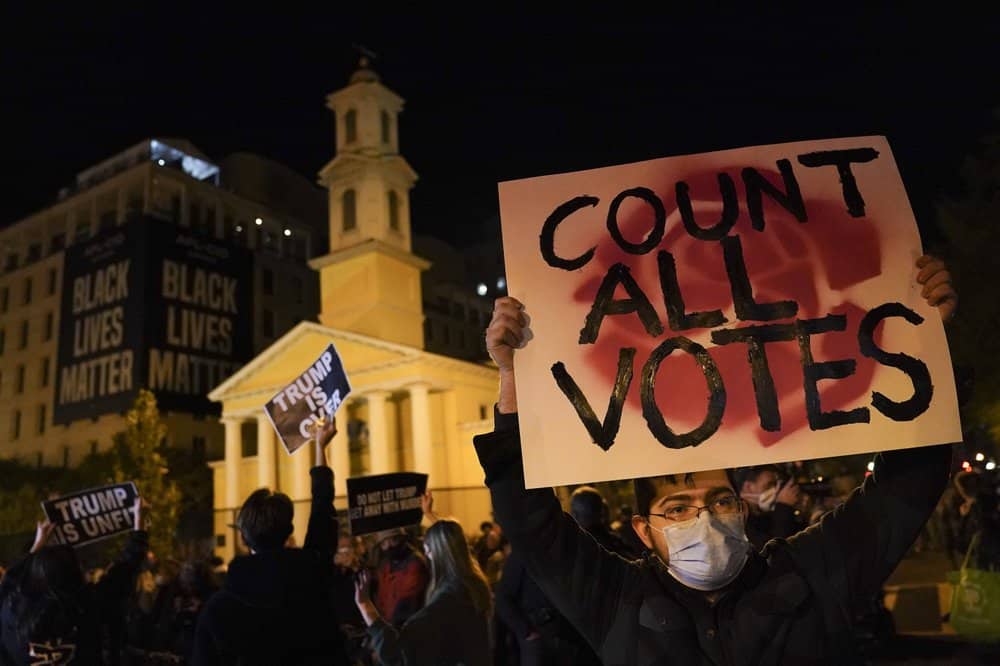Election 2020 race too close to call, the wins and losses for Trump, Biden forts so far
Wed 04 Nov 2020
President Donald Trump won Florida, the nation’s most prized battleground election state, and he and Democrat Joe Biden shifted their focus early Wednesday to three Northern industrial states that could prove crucial in determining who wins the White House.
Neither candidate had the 270 Electoral College votes needed to win the presidency during an epic campaign that will shape America’s response to the surging pandemic and foundational questions of economic fairness and racial justice.
The two men were locked in tight races across the country, with Trump retaining Texas and claiming the battlegrounds of Ohio and Iowa while Biden won Arizona becoming the second Democratic presidential candidate since 1948 to win the longtime Republican stronghold. The former VP also bagged Minnesota and New Hampshire, two modest prizes the incumbent had hoped to take.
Races were too early to call in some of other fiercely contested and critical states on the map, including North Carolina, Georgia and Pennsylvania. The president, by early Wednesday, had retained many states he won in 2016 and, as long predicted, the race in part seemed to rest on the three northern industrial states where Trump most surprised the Democrats four year ago Michigan, Wisconsin and Pennsylvania.
Biden, briefly appearing in front of supporters in Delaware, urged patience, saying the election “ain’t over until every vote is counted, every ballot is counted.”
“It’s not my place or Donald Trump’s place to declare who’s won this election,” Biden said. “That’s the decision of the American people.” He warned the voters to not be swayed and “stay in line.”
Trump has since made a statement claiming “we did the election” despite the final results still not yet in. “This is a fraud on the American public” he decried saying he will go the Supreme Court: “We want all voting to stop.”
Millions of voters braved their worries about the virus — and some long lines — to turn out in person, joining 102 million fellow Americans who voted days or weeks earlier, a record number that represented 73% of the total vote in the 2016 presidential election.
Early results in several key battleground states were in flux as election officials processed a historically large number of mail-in votes. Democrats typically outperform Republicans in mail voting, while the GOP looks to make up ground in Election Day turnout. That means the early margins between the candidates could be influenced by which type of votes — early or Election Day — were being reported by the states.
Florida was the biggest, fiercely contested battleground on the map, with both campaigns battling over its 29 Electoral College votes.
Trump adopted Florida as his new home state, wooed its Latino community, particularly Cuban-Americans, and held rallies there incessantly. For his part, Biden deployed his top surrogate — President Barack Obama — there twice in the campaign’s closing days and benefitted from a $100 million pledge in the state from Michael Bloomberg.
Control of the Senate was at stake, too: Democrats needed to net three seats if Biden captured the White House to gain control of all of Washington for the first time in a decade. But Republicans maintained several seats that were considered vulnerable, including in Iowa, Texas and Kansas.
The parties traded a pair of seats in other early results: Democratic former Colorado Gov. John Hickenlooper defeated incumbent Sen. Cory Gardner, and in Alabama Republican Tommy Tuberville knocked off Sen. Doug Jones. The House was expected to remain under Democratic control.
As the results began to come in, the nation braced for what was to come — and an outcome that might not be known for days.
Putting up shields down in a tense battle, the White House installed a new anti-scaling fence, and in downtowns from New York to Denver to Minneapolis, workers boarded up businesses, and pitched up survival camps lest the vote lead to unrest.
With the worst public health crisis in a century still fiercely present, the pandemic — and Trump’s handling of it — was the inescapable focus for 2020.
For Trump, the election stood as a judgment on his four years in office, a term in which he bent Washington to his will, challenged faith in its institutions and changed how America was viewed across the globe. Rarely trying to unite a country divided along lines of race and class, he has often acted as an insurgent against the government he led while undermining the nation’s scientists, bureaucracy and media.
Biden spent the day last-minute campaigning in Scranton, Pennsylvania, where he was born, and in Philadelphia with a couple of local stops in Wilmington, Delaware, where he was spending Election Night.
The momentum from early voting carried into Election Day, as an energized electorate produced long lines at polling sites throughout the country. Turnout was higher than in 2016 in numerous counties, including all of Florida, nearly every county in North Carolina and more than 100 counties in both Georgia and Texas. That tally seemed sure to increase as more counties reported their turnout figures.
Voters braved worries of the coronavirus, threats of polling place intimidation and expectations of long lines caused by changes to voting systems, but appeared undeterred as turnout appeared it would easily surpass the 139 million ballots cast four years ago.
[Sourced from Agencies]

 Apr 16 2024
Apr 16 2024











